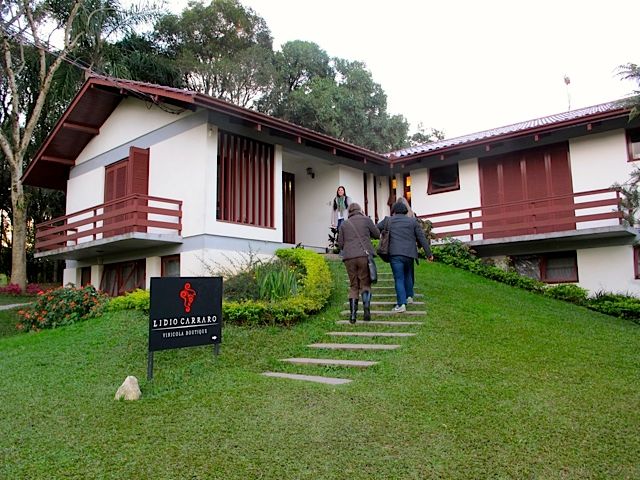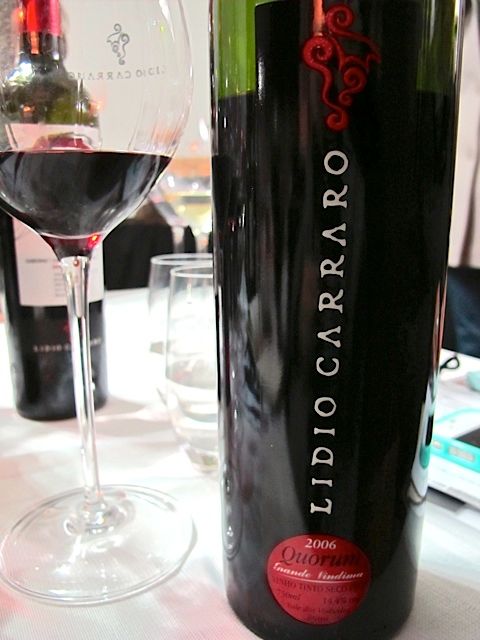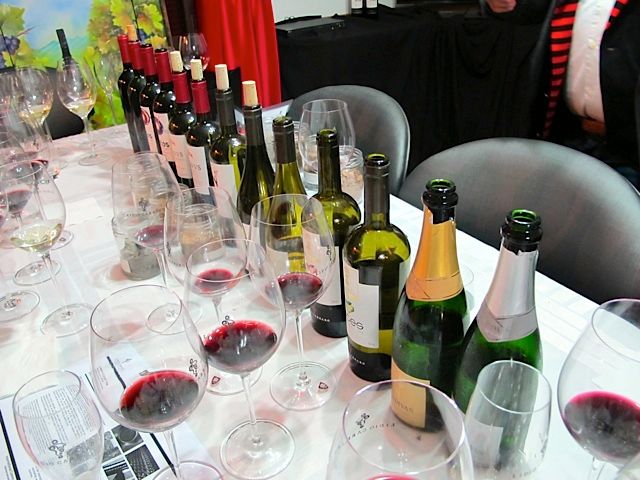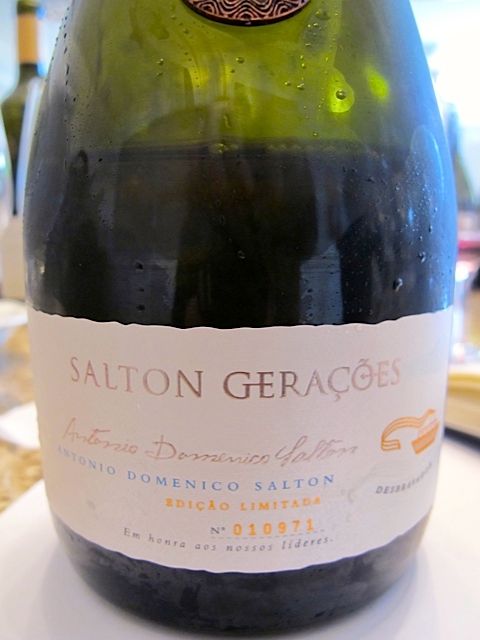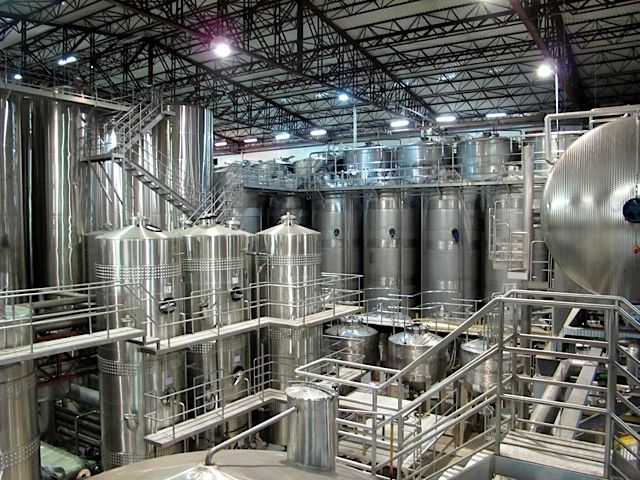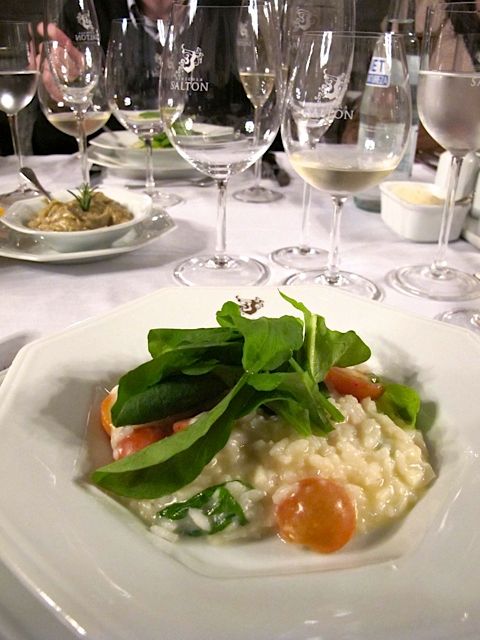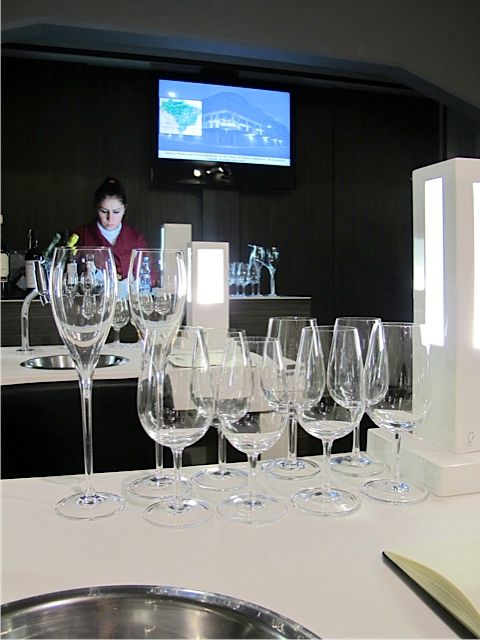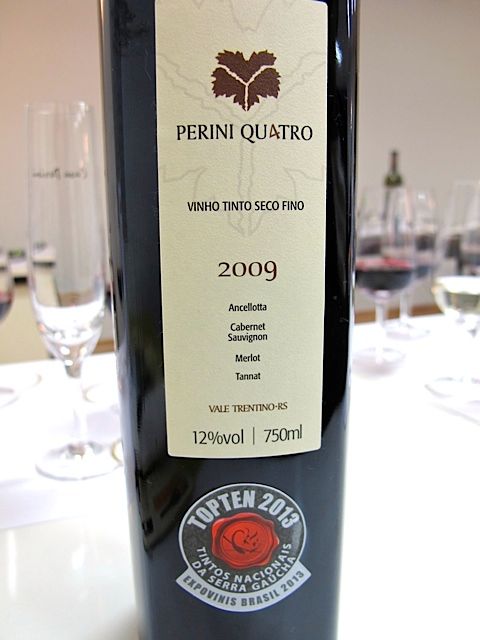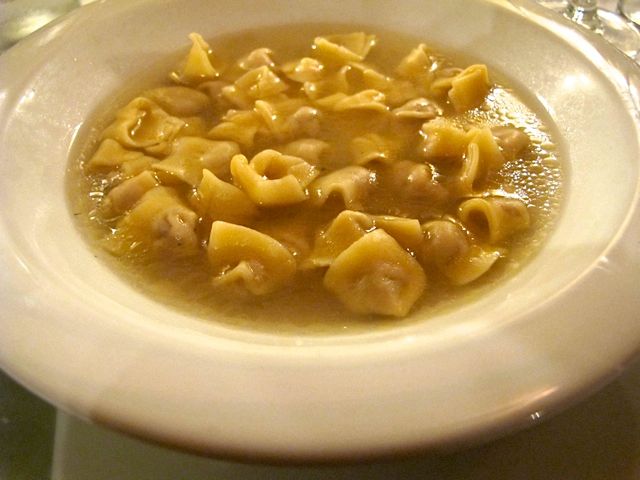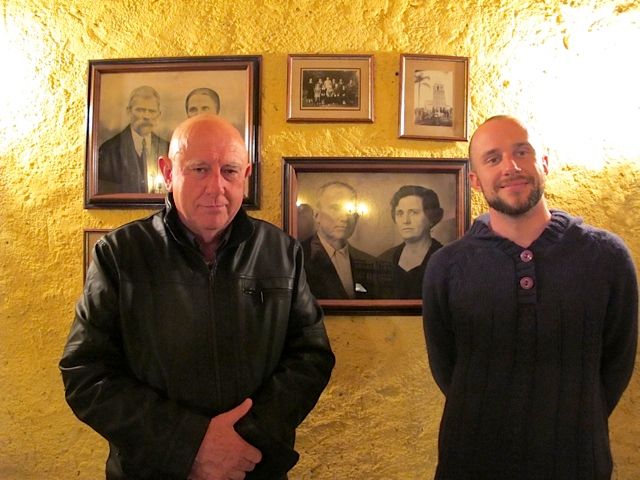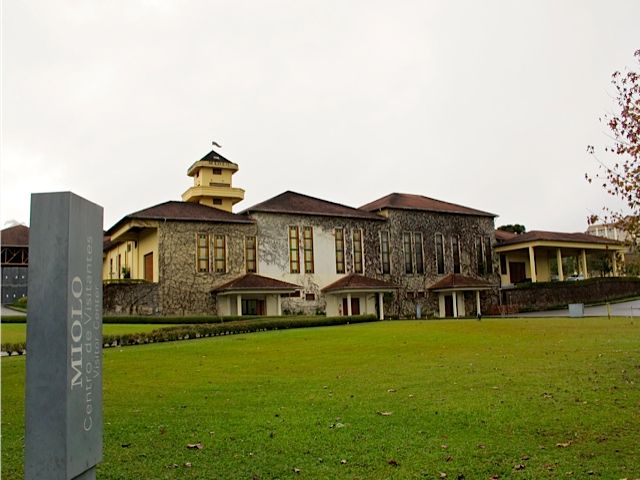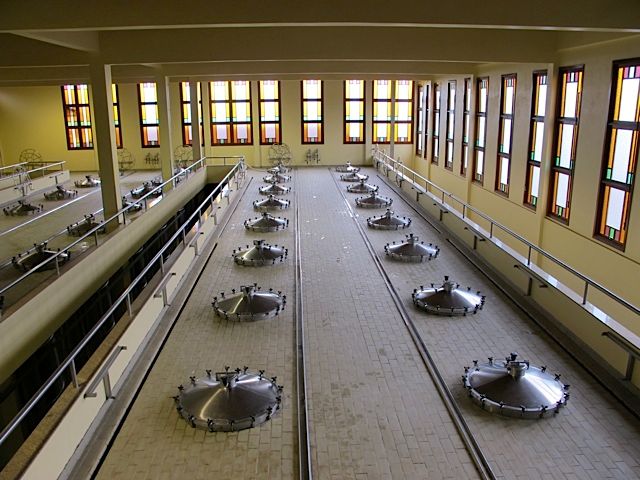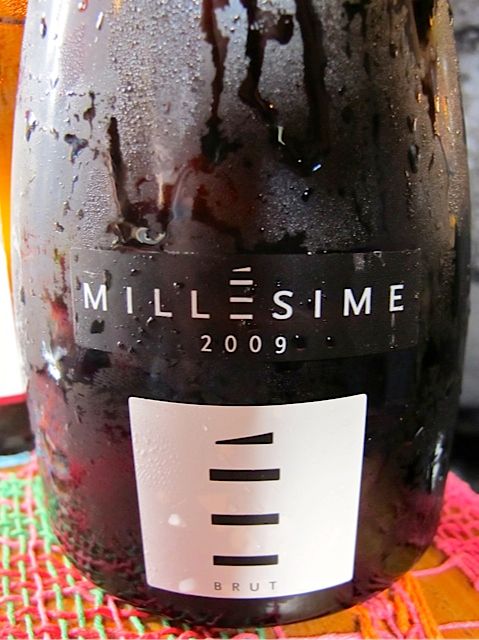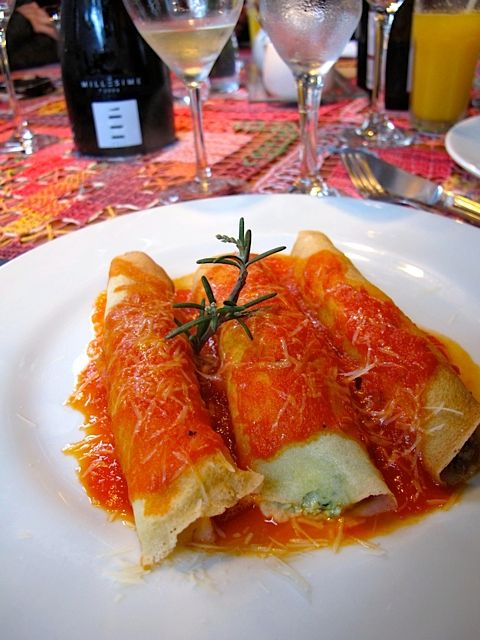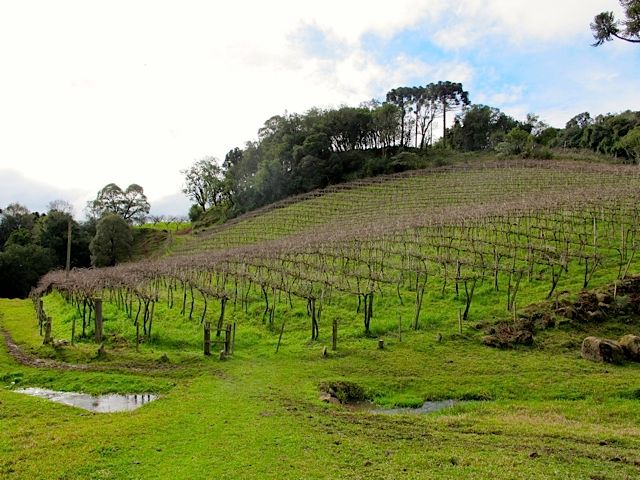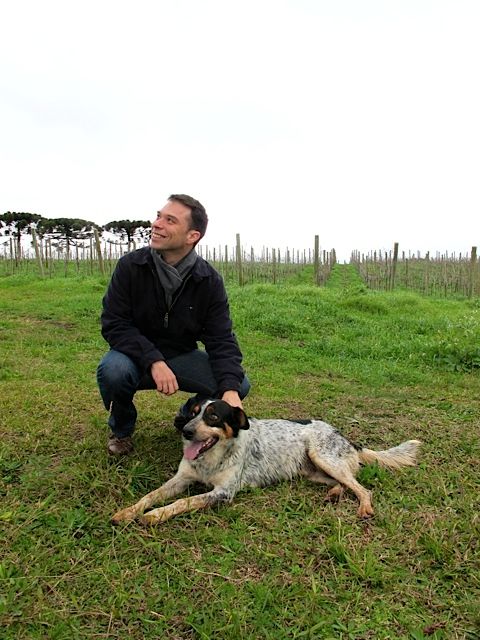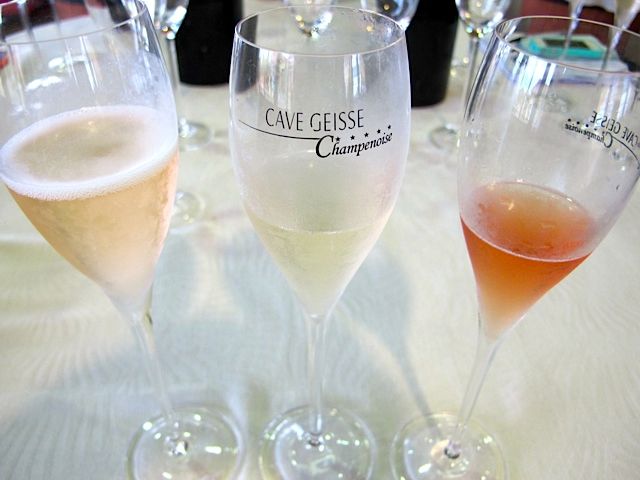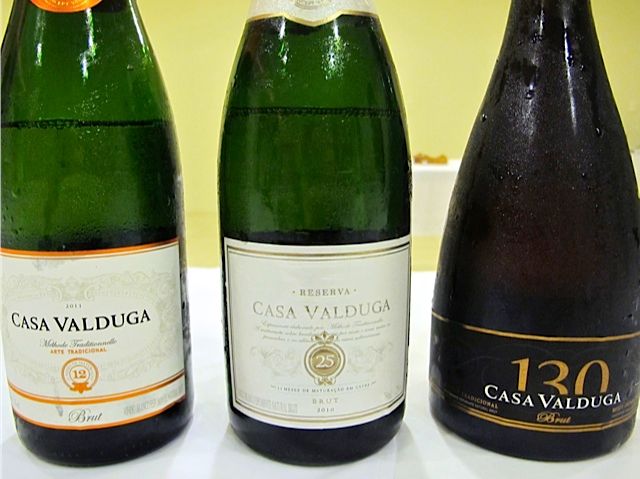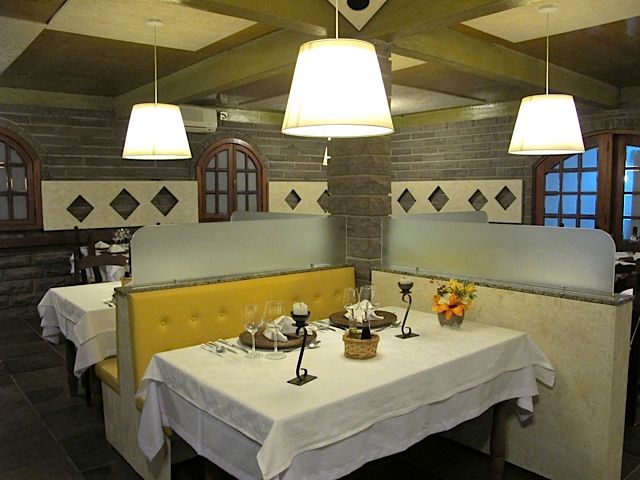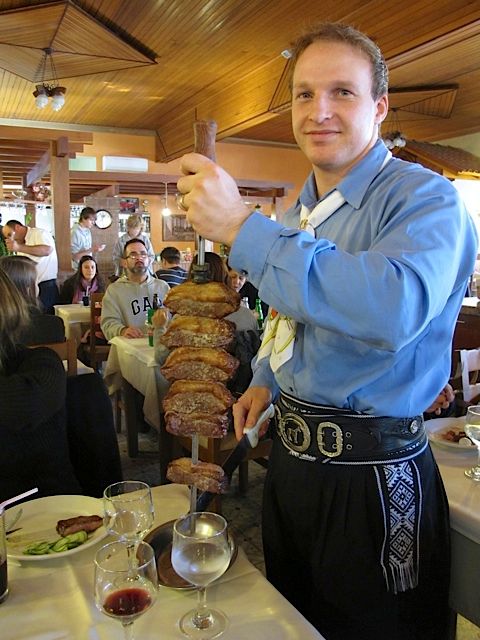When I was invited to visit Brazil to learn about their wines, like many people, I thought, “Isn’t it too damn hot to make good wine there?” Spoken like a true gringa. As we all know, Brazil is huge (it’s just about the size of the continental United States), and it makes a lot of wine: Brazil is the fifth largest producer of wine in the Southern Hemisphere! So no, Brazil is not all beach and jungle—it actually has quite a bit of geographic diversity. When I left San Francisco, it was a foggy June morning—but as soon as I got off the plane in Porto Alegre and made my transfer to the town of Bento Gonçalves, I was grabbing for my heavy sweater. It was damp, and chilly, and hilly—not what you typically think of when picturing Brazil in your mind.
Some of my wino friends (who have a little bit of knowledge of Brazilian wine) would ask, “Wait, don’t they do two harvests there?” Well, there is a region closer to the equator, Vale do São Francisco, where it’s so warm they actually can crank out two harvests a year, but that area only supplies about 14 percent of Brazil’s total grape production, so don’t let that taint your perception of Brazilian wine.
The area that’s particularly of interest is in the far south, which has four wine-growing regions: Santa Catarina, Serra Gaúcha (and Vale dos Vinhedos/”Valley of the Vineyards”), Serra do Sudeste, and Campanha (which is the farthest south, flanking Uruguay). I was invited to explore and learn more about the wineries of Serra Gaúcha (which is in the southernmost state of Rio Grande do Sul), and I was so fascinated with the history of this unique region. Because check this out: the area is full of Italians!
Thousands of Italians came over in 1875 and later (once the slave trade was outlawed and the landowners claimed they would need laborers, the Brazilian government encouraged immigration from Italy). The Brazilian government set up four settlements to receive Italian immigrants; most Italians came from the northern regions of Italy, like the Veneto and Trento. And like the good agriculture-loving people they are, they started developing wine production in the area, which looked and felt a lot like home (although for a while there, they were stuck with native grapes—which were American hybrids). Fast-forward, and some of the more progressive winemakers made the switch to Vitis vinifera, and changed up their vine systems from the omnipresent pergola to more modern formats.
The climate in Serra Gaúcha (and Vale dos Vinhedos) is a lot like Italian wine country, but more humid. One thing I appreciated about the wines is that since the area is on the cooler side, you’ll find most wines stay low in alcohol, with reds clocking in around 13 percent. But for anyone who knows me, you know I love my bubbles, and the area is known for its sparkling wines! I made sure to drink a lot of them.
One thing to note: since Vale dos Vinhedos is a D.O. (the only one in Brazil), wines that are labeled Vale dos Vinhedos have specific rules to follow (you can read more about them here.
We posted up in Bento Gonçalves, the principal town in wine country. It’s not a particularly scenic city, although the outlying areas are quite pretty. The first winery we visited was Lidio Carraro, which was a great benchmark to set for the rest of the trip, let me tell you. While the family has been making wine for five generations (with roots in the Veneto), their boutique winery didn’t start until 1998 (they were farming grapes before), and their first vintage was in 2002. There are many unique things about this winery, the big one being they don’t use wood on any of their wines! Just steel tanks. Their wines are unfiltered as well. You really get the opportunity to taste the purest expression of the grape—their wines have a wonderful freshness. (I enjoyed tasting their 2011 tempranillo because you really experience a true representation of the grape.) They were also the first in Brazil to use a gravity-flow system.
A big recent honor was that Lidio Carraro was tapped by FIFA to create the official wine for World Cup 2014—they are releasing 600,000 bottles of their “Faces” wines (a white and a red—the red cleverly has 11 grapes for the 11 players) for the event.
While they have vineyards in the Vale dos Vinhedos, many of their premium wines come from the drier Encruzilhada do Sul (which has more granite in the soil, while Vale dos Vinhedos is more basaltic). Their portfolio includes an excellent chardonnay (we tried the Dádivas 2012), with nice minerality and melon (and a shocking richness for no oak), but red wine lovers will really want to check out their premium blends, like the Elos 2009, an intense blend of touriga nacional and tannat that had feminine/perfumey notes yet carried dark fruit and pepper from the tannat (the Elos wines are only released during outstanding vintages); while the Grande Vindima Quorum gives you the chance to taste wine from Vale dos Vinhedos, a blend of merlot, cabernet sauvignon, tannat, and cabernet franc (the 2006 was packing some tannins and fruit).
This winery was so impressive—their practices are really on the cutting edge, and they do a lot to elevate the reputation of wines from the area. If you visit Serra Gaúcha, you don’t want to miss it (and they’re one to look for on lists and shelves here!).
The next winery we visited was Salton, which kind of blew my mind with its level of production. It was the first winery in Brazil (1910), in addition to being one of the biggest sparkling wine producers and are in the top three of still wine producers, making 18-19 million bottles per year. But they are also family-owned, with the third generation currently running the show (they have around 50 labels). They work with grapes from all over the region, including Pinto Bandeira (more on this later) and farther south in Campanha (which is drier and has clay and granite soil).
The bottling line is something to see: they bottle 7,000 bottles of sparkling an hour, which comes out to 80,000-100,000 bottles a day, and 8 million bottles of sparkling a year. I have never seen anything on this scale—the Charmat tanks were ginormous.
Our tasting (of 17 wines!) only featured a few sparklings, however. I enjoyed the Intenso brut traditional method (70 chard/30 pinot noir, one year in bottle), and there is an Intenso brut made with 30 percent riesling (a special project). I was happy they cracked open the limited production (12,000 bottles) Salton Gerações Antonio Domenico Salton sparkling—the blend spanned three years (2008-2010) and was 50 pinot noir/50 chard, on the lees for three years—it was so yeasty, with beautiful structure. They are also working on an albariño sparkling, plus trebbiano as well, cool stuff.
As for still wines, the 2012 Intenso sauvignon blanc/viognier was minerally, salty, and not tropical (it actually made me hungry), while the 2012 Intenso teroldego was leathery and vegetal (the Intenso line is a new one, which just launched in 2012). Bordeaux lovers will want to check out the 2009 Salton Gerações Paulo Salton, a balanced blend of cabernet sauvignon, merlot, and cab franc that will age well.
Over lunch (which was marvelous by the way—their on-premise cook made us a beautiful meal, which included a rockin’ risotto), our hosts talked about how Brazil is this other world of wine, spanning the old and the new. To elaborate: you have the Italian heritage and winemaking tradition, with a tendency for lower-alcohol and high-acidity wines, but then you have the South American climate—that isn’t Chile or Argentina—yielding wines that are easy drinking, fresh, and fruity. It’s a total Old World-New World combo deal.
We visited Aurora, a cooperative that gets more than 150,000 visitors a year. The story of the cooperative is an interesting one—it started with 16 families, and now has 1,100 families taking part, making it the largest winery in Brazil (side note: grape juice is actually a huge part of their production). It’s a pretty major operation: you have four winemakers (one started at the age of 18!) for 70 labels—the mind reels when thinking of all the tanks to keep track of for blending, storage, and fermentation.
While in their modern and contemporary tasting room, I tasted a chardonnay that suddenly rattled my palate. I was like, wait, hold on, tell me about this wine! It was a 2011 Aurora chardonnay from Pinto Bandeira, the second region to receive an Indicação de Procedência (I.P.)/Geographical Indication (G.I.) in Brazil. It’s an optimal area to grow white grapes—it has rocky soil, and wind, and it’s cool, so you get great acidity and minerality. This taste definitely pricked my ears up in anticipation of our impending visit to the region. Our host explained the wine we were tasting was only a second harvest, so the roots would go even deeper in time, yielding even more minerality. They also said there will be some traditional method sparkling wine coming soon from this area. Bring it on.
It was late and chilly when we showed up to Perini, which like many other winegrowers in the area, has their roots in the 1870s when they came over from Trento (not the Veneto). Perini was founded in 1970, and has the brands Perini, Casa Perini, Jota Pe, and Pretinha under its company umbrella, with 90 labels in all. It’s one of the five biggest wineries in Brazil, with 11 million bottles annually, and exporting 400,000 to the United States. Perini uses a Y-shaped espalier system, which helps with humidity (always an issue) and offers good exposure to sunlight.
While we were there, they had us taste through their Macaw wines, which are entry-level wines that they export. One fun revelation is their moscato, which we often expect to be sickly sweet, but this had an unexpected dryness and acidity. Kind of fun. You’ll see a lot of moscato in Brazil, give it a whirl.
On the opposite end of the price spectrum is their limited release Perini Quatro—we tried the earthy and complex 2009, made with four grapes from their estate (ancellotta, cabernet sauvignon, merlot, and tannat). But it was at a Brazilian wine tasting here at home that I got to try the 2010 marselan, which had gorgeous fruit and structure, with violet and cherry, so good. Oh, and I totally brought home a bottle of their Pretinha liqueur, which was like a cross between a grappa and a smooth amaro, made with lots of herbs and fruits, a perfect digestif. In fact, I am drinking it as I write this thing at 11:30pm. That’s how I roll.
The dinner we had at Perini was so homey—I kept feeling like I was in Italy with all the handmade cappelletti in brodo we kept encountering at every turn (a dream on those chilly nights, I never got tired of it!). I also love all the family-run businesses in the area, no matter how big they are—it’s such an honor to meet the multiple generations and hear their story, and how they’re keeping up with the times (Perini has their own treatment plant for all the water they use, which is pretty awesome).
Another day, more wine! We started the day at Miolo, a name recognized worldwide—and the largest private wine company in Brazil (and the largest exporter). The Miolo family came to Vale dos Vinhedos from Italy in 1897 and planted grapes, but their winery wasn’t founded until 1989 (check out Lote 43, their Bordeaux-style wine, which they only release in special years and honors founder Giuseppe Miolo’s original plot of land).
Miolo is the largest producer of traditional method sparkling wine in Brazil, and their offering runs the gamut, from their Cuvee Tradition brut rosé (interestingly with some merlot in addition to chard and pinot noir) to the creamy 2009 Millesime we tasted over lunch (it’s their premium release made with chardonnay and pinot noir, hand-riddled). The Miolo Wine Group has vineyards all over Brazil, and while we were there, we learned about their progress in Campanha (a site on the border of Uruguay that started emerging in the 1970s thanks to a U.C. Davis researcher being fired up on the area).
Touring their modern facility was impressive—we saw their special carts that wheel right over the tanks so there’s no pumping into the tanks, and the belts they use for hand-sorting special releases. Michel Rolland consulted for Miolo for 10 years but they are no longer working with him—I’m curious to see the direction their red wines take now.
Miolo brought us to lunch at one of the best restaurants of the trip: Sapore + Piacere. The place was artsy and eclectic, with a tasty salad buffet at lunch (Brazilians love their salad bars), good soups, and our main courses tasted so freshly made, with a light touch. Great spot. Over lunch we also got to try the 2012 alvarinho, from Campanha, the only one in Brazil (this was the second harvest). Someone failed to make notes about how it tasted, oops. I blame all the wine!
My absolute highlight of the entire trip was our visit to Cave Geisse, up in the hills of Pinto Bandeira. The winery was founded in 1979 by Chilean enologist Mario Geisse, who was originally hired by Moët & Chandon do Brasil in 1976 to help develop sparkling wine in Serra Gaúcha. He eventually scouted his own plot of land in Pinto Bandeira, 89 acres, to plant his first seedlings of chardonnay and pinot noir. This plot has good drainage (there is just so much rain here) and exposure to the sun—there’s a one-meter layer of stone above the basaltic soil.
The winery’s production is just 200,000 bottles a year, and unlike all the other wineries we toured, Geisse was the first to say they don’t use pesticides (the humidity is a big factor in Brazilian winemaking). They use TPC (thermo pest control), a device developed in Chile that blasts the vines with a hot, dry wind that registers 130 degrees Celsius, at 140 km/hour. They were the first to use TPC in Brazil, and have been using it with success for seven years.
The wines we tasted were my favorite sparklings of the trip—their focus here is clearly on quality, not quantity. The grapes are on a trellised system (which yields less, but better quality), and they were the first to put chardonnay on a trellised system in the area. Geisse only uses the traditional method, and everything is hand-riddled.
We tasted through many of their wines, which included the notable 2009 Cave Geisse Blanc de Blancs, with three years on the lees; the 2011 Cave Geisse Rosé (very winey and rich, with some figgy notes); and the bottle I still wish I had bought to bring home, the award-winning 2008 Terroir Rosé, which was 50 percent chardonnay and 50 pinot noir, four years on the lees, with a gorgeous effervescence, structure, and elegance. This wine still haunts me, but everything we tasted was mightily impressive. I was ready to move into their guesthouse up on the hill, what a special place. I’d be so happy to see Cave Geisse on more lists so I could taste these wines again!
Next stop: Casa Valduga, which is known for having the largest cellar in South America, with a capacity for six million bottles. Whoa. Sadly we got there too late in the evening to see it, but the tasting more than made up for it. Casa Valduga makes both sparkling and still wines (50 labels), they only source 10 percent of their grapes (all the rest are theirs), and they proudly state you won’t find their wines in any supermarkets. The family came from Trento in 1875 (see, this is a familiar story), and the company was founded in 1973—they charmingly kept some of the original pergolas to make grape juice, but now use vertical trellises for their wines. The fourth generation is running the business, and Casa Valduga was one of the early wineries to implement the traditional method for sparkling wine in Brazil.
Of the sparklings we tasted, the citrusy Reserva Brut is an excellent bargain considering it has 25 months of maturation behind it (and is riddled in pupitres!), but the Brut 130 really packs a gorgeous, richer style—it costs a bit more, but has 36 months on the lees behind it, giving it a lovely toast and intensity (it also sees some oak). The blend is 70 percent chard (comprised of three vintages) and 30 percent pinot noir. Of the stills we tried, the 2010 Raízes cabernet franc stood out with its unexpected red cherry, and a taste of green pepper (another great deal), and the 2012 Leopoldina chardonnay, with good mouthfeel and green apple, and no oak. We also tasted a couple of wines from their Encruzilhada do Sul vineyards, like the intense 2010 Identidade arinarnoa (a cross between cabernet sauvignon and tannat), which paired extremely well with our meat course at dinner.
This is a fab winery to visit: the grounds are quite lovely, and their cozy restaurant is open for lunch and dinner—we enjoyed local dishes like the cappelletti (of course) and risotto with mushrooms and shrimp (risotto is another favorite dish of the region).
Want to see more pictures? Here’s my photo album of the trip on Flickr!
Where to stay:
If you are planning to visit Bento Gonçalves, I wouldn’t recommend the place we were put up in, it was pretty grim. But I’ve heard Hotel & Spa do Vinho Caudalie across the road from Miolo is the way to go.
A couple of other spots: the suites and guesthouses at the Pousada Villa Valduga looked quite nice—we took a peek during our visit. Another good option (I was told) is the Farina Park Hotel.
Where to eat:
The places we dined at were a bit up and down. Some of the best food was really at the wineries (like Casa Valduga’s Restaurante Maria Valduga, and Tavern Perini). As I mentioned, Sapore + Piacere is fantastic. You can also get a rustic meal at Canta Maria, like the cappelletti in brodo (“sopa de capeletti”), roast chicken, and more meats.
Other places recommended (but I didn’t try): reportedly Restaurante Casa di Paolo has the best chicken and Italian in town, and Valle Rustico Restaurante is also supposed to be tasty.
Other things to do:
You can visit the nearby towns of Canela (which has a beautiful cathedral and the nearby Caracol park and waterfalls) and Gramado (which has a bit of Alpine flair to it)—both can get snowy in the winter. We didn’t get a chance to explore the Caminhos de Pedra/”stone pathways” but you can visit the original Italian immigrant homes and other stone buildings.
If you are trying to time your trip, harvest happens in Vale dos Vinhedos in February and March, FYI.
Final thoughts:
One thing that drove me a little crazy outside of Bento Gonçalves was how few Brazilian wines I found on wine lists elsewhere in Brazil. I’d find Prosecco and Champagne, but no Brazilian sparkling, why? It ends up astronomically high taxes are to blame—you can actually find their wines cheaper outside of Brazil. I know, crazy. (This Reuters article from last year helps explain the situation.)
And it seems Brazilians love the allure of imports, and are less inclined to consume domestic products, so that’s another issue. During my week in Rio, I found myself talking up Brazilian wine to a lot of restaurants I visited, telling them names of some of the wonderful wineries I had just visited. Many had no idea how good some of their domestic wines actually are. But then you have a place like the Copacabana Palace, and their house sparkling is proudly the brut from Cave Geisse.
There is a lot of room for wine education in Brazil—they really don’t drink much wine! The per capita consumption only clocks in at less than half a gallon per person per year (Americans drink three gallons). I also couldn’t believe how many places served their sparkling wines glacially cold—even the winemakers! Brazilians like their drinks cold, but when it comes to tasting wine, expect having to wait around a bit before you can even taste it.
If you’re curious about tasting some of these wines (and learning more), the Wines of Brasil site is a good resource, and you can hop over to the Brazilian section on Snooth or check out Wine-Searcher. Unfortunately it would be too time consuming for me to figure out all the places where any of these wines are poured or sold, and how much they cost, but I will update this piece as more information becomes available. Saúde!
Want to see more pictures? Here’s my photo album of the trip on Flickr!
